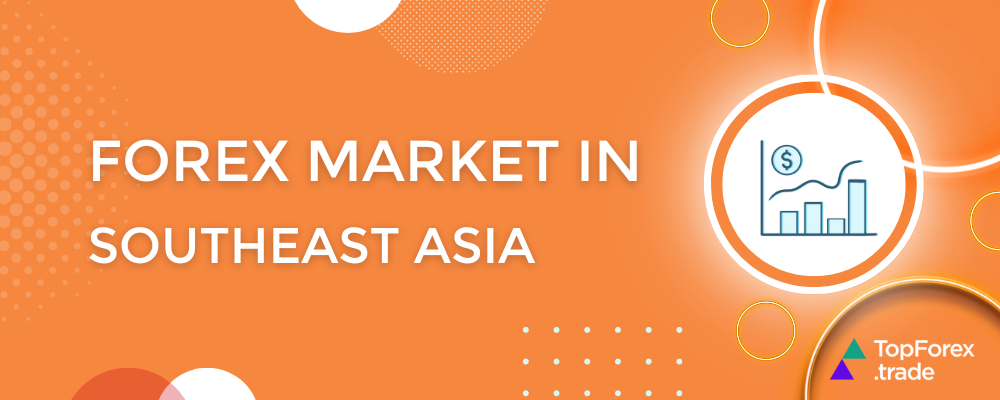Forex trading in Southeast Asia: trends and predictions

Forex trading in Southeast Asia is rapidly gaining momentum, driven by strong economic growth and a surge in tech-savvy investors. As more people engage in trading, the region is establishing itself as a significant player in the global Forex market.
In this article, we’ll explore the latest trends in Southeast Asia’s Forex trading scene and provide insights into future developments. We’ll cover key factors like economic changes, regulatory shifts, and technological advancements that are shaping the market, offering a glimpse into what traders can anticipate going forward.
Forex trading in Southeast Asia: trends, influencing factors, and trading tips

The values of currencies, stocks, raw materials, and other assets are in constant motion, influenced by various factors including economic data, geopolitical events, and market sentiment. Here’s a closer look at recent changes, trends, and what drives these fluctuations, illustrated with examples.
Currency quotes in Southeast Asia
- Volatility and market trends:
Example: The US Dollar (USD) has recently seen significant fluctuations against the Euro (EUR) and the Japanese Yen (JPY). For instance, during the COVID-19 pandemic, the USD surged as investors sought safe-haven assets. However, as the global economy began recovering and the Federal Reserve signaled changes in interest rates, the USD experienced periods of volatility.
Southeast Asia example: The Thai Baht (THB) experienced appreciation against the USD as Thailand’s economic recovery showed promising signs, with increased tourism and export growth boosting investor confidence.
NOTE: You can learn more about FX trading in Thailand in the article Top Forex brokers in Thailand: trading CFDs for currencies, commodities, Cryptocurrencies, and more.
Trading tip: Stay updated with regional economic reports and global events. For example, monitor Thailand’s tourism data and export performance, as these can provide early signals for Baht movements.
- Economic indicators:
Example: The GBP/USD exchange rate was heavily influenced by Brexit negotiations and the UK’s economic performance. After the UK secured a trade deal with the EU, the British Pound (GBP) strengthened against the USD.
Southeast Asia example: The Indonesian Rupiah (IDR) fluctuated based on Indonesia’s GDP growth rates and inflation data. Positive economic reports led to Rupiah appreciation, while economic uncertainties or weaker data caused depreciation.
Trading tip: Focus on key economic indicators such as GDP growth, inflation, and interest rates. For instance, if Indonesia reports strong GDP growth, consider long positions in IDR.
- Monetary policies:
Example: The European Central Bank’s (ECB) decision to implement negative interest rates and a large-scale bond-buying program impacted the EUR/USD exchange rate, with the Euro weakening against the Dollar as a result.
Southeast Asia example: The Bank of Thailand’s interest rate cuts aimed at stimulating the economy led to a weaker Baht, as lower rates can make a currency less attractive to investors.
Trading tip: Track central bank announcements and policy changes. If the Bank of Thailand signals further rate cuts, it may be an opportunity to short the Baht.
Stock quotes in Southeast Asia
- Market sentiment and economic outlook:
Example: The technology sector, represented by indices like the NASDAQ, saw dramatic gains during the pandemic as remote work and digital services became more crucial. Companies like Apple and Microsoft saw their stock prices soar due to increased demand for technology.
Southeast Asia example: In Southeast Asia, stocks in the healthcare sector, such as those of pharmaceutical companies, performed well due to heightened demand for health-related products and services during the pandemic.
Trading tip: Identify sectors with strong growth potential. For instance, consider investing in Southeast Asian healthcare and technology stocks, which have shown resilience and growth during and after the pandemic.
- Sector-specific trends:
Example: Oil companies such as ExxonMobil and Chevron experienced a downturn in stock prices as oil prices plummeted due to decreased demand during lockdowns and increased production from non-OPEC countries.
Southeast Asia example: Indonesian palm oil companies like Wilmar International saw fluctuations in stock prices based on global demand for palm oil and environmental regulations affecting production.
Trading tip: Diversify your portfolio to manage sector-specific risks. Investing in a mix of technology, healthcare, and commodities can help balance exposure and capitalize on various market trends.
- Investment flows:
Example: Emerging markets saw increased foreign investment flows in 2021 as global investors sought higher returns, with significant capital inflows into Southeast Asian stock markets such as the Philippine Stock Exchange.
Southeast Asia example: The Singapore Stock Exchange benefited from increased foreign investment, boosting stock prices in sectors like finance and technology.
Trading tip: Monitor foreign investment trends and follow the money. Increased foreign inflows into a market often lead to higher stock prices, presenting buy opportunities in the affected sectors.
Commodities and raw materials quotes in Southeast Asia
- Supply and demand dynamics:
Example: Oil prices have experienced dramatic swings. For instance, in 2020, prices fell sharply due to a demand collapse during the pandemic and a price war between Saudi Arabia and Russia. Conversely, as economies reopened and demand recovered, prices surged again.
Southeast Asia example: The price of rubber, a key raw material in Southeast Asia, rose significantly due to supply chain disruptions and increased demand for medical gloves during the pandemic.
Trading tip: Stay informed about supply chain issues and demand trends. For example, if there are disruptions in rubber supply or spikes in demand for medical supplies, consider investing in rubber futures or stocks of rubber-producing companies.
- Geopolitical events:
Example: The US-China trade war impacted the prices of metals like steel and aluminum, with tariffs imposed on imports leading to higher domestic prices and supply chain disruptions.
Southeast Asia example: The conflict in Myanmar affected tin prices, as Myanmar is a major global supplier of tin, leading to price increases due to concerns over supply disruptions.
MORE ABOUT GEOPOLITICAL TENSIONS AND FX MARKET: How geopolitical tensions influence Forex markets: insights and strategies
Trading tip: Geopolitical events can create both risks and opportunities. Keep a close watch on news that might affect supply chains and prices of key raw materials, and be prepared to act quickly on emerging trends.
- Environmental and policy changes:
Example: The transition to renewable energy sources has influenced the prices of raw materials like lithium and cobalt, which are critical for electric vehicle batteries. Increased demand for these materials has driven their prices higher.
Southeast Asia example: Indonesia’s new regulations on mining and export restrictions for nickel have impacted global nickel prices, as the country is a major producer of this essential raw material for stainless steel and batteries.
Trading tip: Understand the impact of regulatory changes and sustainability trends on raw materials. If Indonesia tightens nickel export regulations, consider long positions in nickel futures or investing in companies involved in nickel mining.
Forex trading trends in Southeast Asia and future outlook

- Increased market sensitivity: All asset classes are becoming more responsive to global economic indicators and geopolitical developments. For instance, the recent tightening of monetary policies by central banks worldwide has led to notable shifts in currency and stock prices.
- Digital transformation: The rise of algorithmic trading and high-frequency trading is making price movements more rapid and sometimes more volatile, as seen in the quick reactions to economic data releases.
- Focus on sustainability: The growing emphasis on ESG (Environmental, Social, and Governance) criteria is affecting investment decisions and asset valuations, with companies and raw materials meeting sustainability standards seeing increased investment.
Understanding these trends and their underlying drivers can provide valuable insights for traders and investors navigating the complexities of financial markets.
Forex trading strategies in Southeast Asia

Effective trading strategies are essential for navigating the complexities of financial markets. Here are some general trading strategies with practical examples to help you make informed decisions.
1. Risk management
- Strategy: Employ risk management techniques to protect your capital from significant losses.
- Example: Suppose you are trading the USD/THB (US Dollar/Thai Baht) currency pair. You decide to risk 2% of your trading account on each trade. If your account balance is $10,000, you set a stop-loss order such that the maximum loss on a trade does not exceed $200. This way, even if the trade goes against you, your losses are limited, protecting your overall capital.
2. Technical analysis
- Strategy: Use technical analysis tools to identify potential entry and exit points based on historical price movements.
- Example: You are interested in trading the stock of Singapore Airlines (SIA). You observe that the stock has formed a “double bottom” pattern on its chart, indicating a potential bullish reversal. Additionally, the stock price has crossed above its 50-day moving average, confirming the upward trend. You decide to enter a long position, aiming to capitalize on the expected price increase.
3. Diversification
- Strategy: Spread your investments across various asset classes and regions to reduce risk and enhance potential returns.
- Example: Instead of investing solely in Indonesian palm oil companies, you diversify by allocating funds to a mix of Southeast Asian stocks, bonds, and commodities. This might include stocks from the Philippines, Vietnamese government bonds, and gold. Diversification helps mitigate the impact of poor performance in any single asset or market.
4. Stay informed
- Strategy: Keep up-to-date with the latest market news, economic data, and geopolitical developments to make informed trading decisions.
- Example: You are trading Malaysian ringgit (MYR) against the US dollar (USD). By following news sources, you learn that Malaysia’s central bank plans to raise interest rates to combat inflation. Anticipating that higher rates will attract foreign investment and strengthen the MYR, you decide to go long on MYR/USD.
5. Long-term perspective
- Strategy: Focus on fundamentally strong assets for long-term investment to achieve sustainable returns.
- Example: You invest in shares of DBS Bank, a leading financial institution in Singapore, based on its strong financial performance, robust business model, and growth prospects. Instead of reacting to short-term market fluctuations, you hold the shares for several years, benefiting from capital appreciation and dividend payouts.
- Strategy: Evaluate the intrinsic value of assets based on financial statements, economic indicators, and industry trends.
- Example: You analyze the financial health of Vietnam’s Vinamilk, one of the largest dairy producers in the region. By examining its revenue growth, profit margins, and market share, you determine that the company’s stock is undervalued. You decide to invest in Vinamilk, expecting its stock price to rise as the market recognizes its true value.
7. Trend following
- Strategy: Identify and follow the prevailing market trend, whether upward or downward, to maximize profits.
- Example: Observing a strong uptrend in the price of crude oil due to increased global demand and supply constraints, you decide to enter a long position in oil futures. You use trend-following indicators like the Moving Average Convergence Divergence (MACD) to confirm the trend and stay invested as long as the upward momentum continues.
8. Contrarian investing
- Strategy: Go against prevailing market trends by buying undervalued assets or selling overvalued ones.
- Example: During a market sell-off, you notice that shares of Singapore’s CapitaLand, a major real estate company, have dropped significantly despite strong fundamentals. Believing the market reaction is overblown, you purchase the stock at a lower price, expecting a rebound once market sentiment improves.
9. Swing trading
- Strategy: Capture short- to medium-term gains by holding positions for several days to weeks, based on expected price swings.
- Example: You identify a trading range for the stock of Malaysia’s Petronas Chemicals. The stock repeatedly bounces between MYR 7.50 and MYR 8.50. You buy near MYR 7.50 and sell near MYR 8.50, capitalizing on the predictable price swings within the established range.
10. Scalping
- Strategy: Make numerous small trades to capture minor price movements throughout the day.
- Example: Trading the USD/SGD (US Dollar/Singapore Dollar) currency pair, you use a one-minute chart to identify tiny price movements. By placing multiple trades each day and aiming for small profits of a few pips per trade, you accumulate significant gains over time.
11. Carry trade
- Strategy: Borrow funds in a currency with a low interest rate and invest in a currency with a higher interest rate to profit from the interest rate differential.
- Example: You borrow Japanese yen (JPY) at a low interest rate and invest in Indonesian rupiah (IDR), which offers a higher interest rate. By holding the IDR and earning the interest differential, you generate a steady return, assuming exchange rate stability.
By understanding and implementing these strategies, you can navigate the complex financial markets more effectively, capitalizing on opportunities and managing risks across various asset classes and regions.
Top Forex brokers to trade in Southeast Asia
Forex trading in Southeast Asia is booming, driven by robust economic growth and increasing interest from both retail and institutional investors. The region’s dynamic market environment necessitates choosing reliable and well-regulated brokers. Here’s a summary of the top Forex brokers for trading in Southeast Asia, highlighting their key features and offerings.
XTB FX trading
XTB is a leading choice for Forex and CFD trading, with a significant global footprint spanning over 190 countries. Known for prioritizing financial security and transparency, XTB is regulated by prestigious bodies like the FCA, CySEC, and KNF.
With a portfolio of more than 1,500 CFDs covering forex pairs, indices, commodities, shares, and cryptocurrencies, XTB offers extensive trading possibilities. Traders can utilize intuitive platforms such as xStation and MetaTrader 4, which come equipped with sophisticated tools for informed trading.
XTB accommodates various trading preferences with multiple account types, including Standard and swap-free accounts, each offering specific fees and advantages. Additionally, XTB provides a wide range of research and analysis tools, including daily market reports, economic calendars, and webinars, to keep traders ahead of market developments and significant events.
Exness FX trading
Exness is a reputable Forex broker, recognized for its diverse range of trading options, including currency pairs, commodities, indices, and cryptocurrencies.
Emphasizing regulatory compliance, Exness is overseen by prominent authorities like the FCA in the UK and CySEC in Cyprus, providing a secure trading environment.
Exness offers competitive spreads that differ based on the account type, with both Standard and Professional accounts available, each offering unique benefits and conditions.
Traders can access customer support via email, live chat, and phone. The broker supports popular platforms like MetaTrader 4 (MT4) and MetaTrader 5 (MT5), renowned for their ease of use and sophisticated charting tools, ensuring a smooth trading experience.
Plus500 FX and CFDs trading
Plus500 is a well-established online trading platform offering Contract for Difference (CFD) trading in numerous Asian countries. CFDs allow traders to speculate on price movements of financial instruments without owning the actual assets.
In Asia, Plus500 is favored for its user-friendly platform, extensive range of tradable instruments, and adherence to regulatory standards. The platform provides access to a variety of CFDs, including stocks, indices, commodities, cryptocurrencies, and Forex pairs. This allows traders to create diversified portfolios and explore various markets based on their trading strategies and preferences.
One key advantage of Plus500 in Asia is its ease of use. The platform features a straightforward and intuitive interface, making it accessible for both novice and experienced traders. Additionally, Plus500 offers a demo account, enabling users to practice trading strategies without financial risk.
Regulatory compliance is another crucial aspect of Plus500’s appeal. The platform operates under the regulations of reputable financial authorities in several Asian countries, ensuring a secure and transparent trading environment. This regulatory oversight provides traders with confidence and security.
Plus500 also offers competitive spreads and leverage, allowing traders to enhance their potential profits. Leveraging allows traders to control larger positions with a smaller initial investment, but it is essential to understand the risks involved.
Customer support at Plus500 is multilingual, providing assistance in local languages across different Asian countries. The platform also supports various deposit and withdrawal methods to meet the needs of its Asian users.
82% of retail investor accounts lose money when trading CFDs with this provider. You should consider whether you can afford to take the high risk of losing your money.
HF Markets FX trading
HF Markets stands out as an excellent choice for traders looking for a broad array of asset trading options. With access to over 1,200 financial instruments, including currency pairs, energies, indices, commodities, ETFs, stocks, and bonds, HF Markets caters to a wide range of trading needs.
The broker offers multiple trading platforms, including MT4 and MT5, available on desktop, web, and mobile devices. Their trading app adds convenience, and the VPS service enhances trading performance.
HF Markets features various account types, such as Premium, Pro, Zero, and Cent, each offering different minimum deposits, leverage, and spreads. Beginners can take advantage of a demo account to practice strategies and familiarize themselves with different instruments before committing real capital.
BlackBull FX trading
BlackBull Markets is a reliable and secure Forex broker known for its wide range of trading instruments. Traders can access commodities, currency pairs, stocks, futures, indices, and cryptocurrencies, providing a broad spectrum of market opportunities.
Operating under Seychelles regulation, BlackBull prioritizes trader safety and regulatory compliance. The broker offers various account types, including standard, prime, institutional, and Islamic (no swap) accounts, as well as a demo account for practice without financial risk.
BlackBull is recognized for its versatile trading platforms, such as MT4, MT5, cTrader, Web Trader, and TradingView. The broker also features specialized platforms like BlackBull CopyTrader and BlackBull Shares, complemented by mobile and tablet apps for easy access.
In addition, BlackBull is dedicated to trader education, offering an educational hub, webinars, and tutorials to help traders enhance their skills and knowledge.
Related articles:
Forex trading in Southeast Asia - FAQ